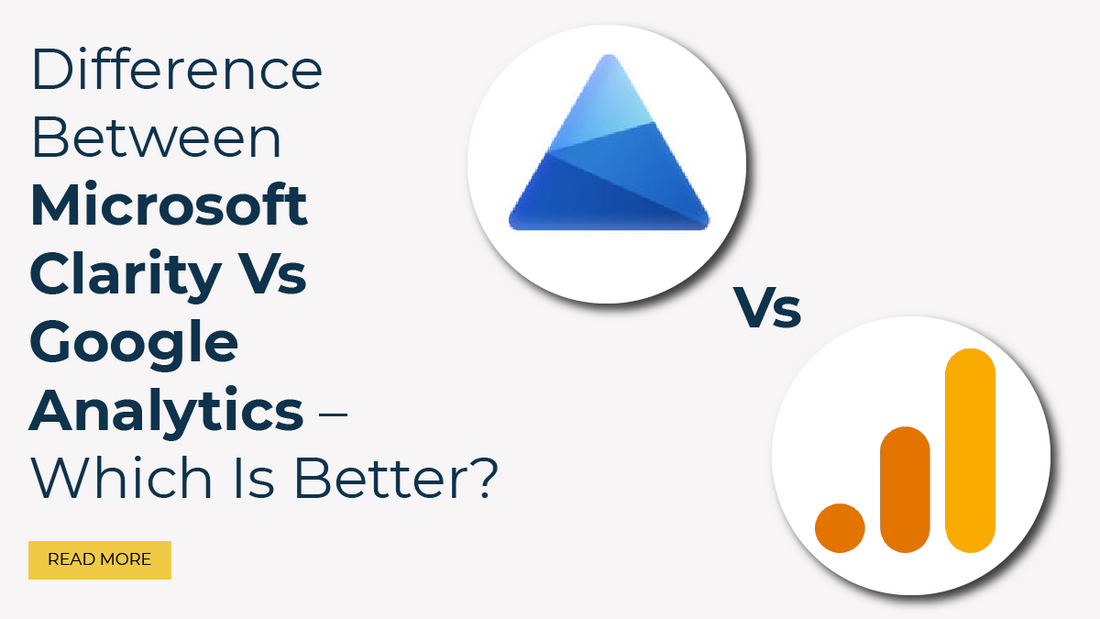
Introduction
Comparing products is something we all do. With so many options available to us, it's only natural that we want to make sure we're using the best possible products that meet our needs.
This is also true for web analysis tools. There are many options out there that promise to provide us with more insights and finer details about our websites.
One of the latest and most exciting tools to make its mark is Microsoft's Clarity. It has some helpful features like session recordings, powerful filtering options, heatmaps, and more. And the fact that it's completely free to use has definitely added to the buzz around this new tool.
However, we also can't ignore the benefits of using the industry favorite, Google Analytics. You can read our blog on adding Google Analytics WordPress for more information.
When two of the biggest names in tech are providing digital toolkits to improve our website's overall performance, it's hard not to compare both offerings and find out which program will give us the best results.
So, if you're wondering which one is better for you, don't worry; we've got you covered. Here, we’ll share the difference between Microsoft Clarity vs Google Analytics.
What is Microsoft Clarity?

Microsoft Clarity is an exceptional web analytics tool and service provided by Microsoft. It is intentionally designed to empower website owners and developers to gain a deeper understanding of user behavior and interactions on their websites.
What Is Google Analytics?

Google Analytics is an unbeatable web analytics service provided by none other than Google itself. It is one of the most widely used and trusted tools for tracking and analyzing website traffic. It offers a comprehensive set of features that empower website owners, marketers, and analysts to gather data about their websites and gain valuable insights into how users are interacting with their online content. Google Analytics equips you with a comprehensive suite of tools to effectively steer your online campaigns toward success with confidence.
Microsoft Clarity Vs Google Analytics

Without a doubt, Microsoft Clarity and Google Analytics are two of the most powerful web analytics tools available today. They allow you to track and analyze user behavior on your website, providing you with valuable insights that can help you optimize your online presence. Although they share some similarities, there are also some differences between the two in terms of features, use cases, and data collection methods. Let's take a closer look at each of these platforms to see how they stack up against each other.
Microsoft Clarity Vs Google Analytics: Cost
Most users consider this to be a crucial aspect. While tools such as Google Analytics are well-suited for high-traffic websites, Clarity stands out as it is free and records 100% of sessions.
Although Google Analytics and other similar analysis tools have a limited free plan with a cap on the number of recordings, Clarity does not have any such restrictions. Thus, Clarity is a much more cost-effective option as compared to Google Analytics, especially when you need to record a large volume of sessions.
Microsoft Clarity Vs Google Analytics: Friction Actions
Clarity has revolutionized the way we identify friction actions by introducing an ingenious tool. With Clarity, users can now effortlessly detect dead clicks, kickbacks, excessive scrolling, and rage clicks.
This unique feature is unparalleled, and we haven't found any other tool that offers similar metrics. It's high time for Google to take notice and add this game-changing feature to their analysis tool.
Microsoft Clarity Vs Google Analytics: Data Privacy
Microsoft Clarity provides advanced features such as masking sensitive information like credit card numbers and anonymizing IP addresses to ensure maximum user privacy. With Microsoft Clarity, you have more control over how data is recorded and displayed.
On the other hand, Google Analytics relies primarily on aggregated data, which requires careful consideration of data privacy regulations and compliance. Overall, Microsoft Clarity provides a more secure and reliable solution for managing user data.
Microsoft Clarity Vs Google Analytics: Integration
Microsoft Clarity can be easily integrated with various website platforms and CMSs, while Google Analytics offers a wide range of integrations with third-party tools and platforms, making it a popular choice among marketers.
However, it's worth noting that while Microsoft Clarity may have limited third-party integrations compared to Google Analytics, it is still a reliable and trustworthy option to consider.
Microsoft Clarity Vs Google Analytics: Volume Data
Clarity is a valuable tool for analyzing user behavior and interactions on your website. However, it cannot be considered a complete analytics solution due to its limited data and reporting capabilities. While Clarity's focus is narrow, Google Analytics for WordPress still remains the best platform for identifying specific pages or sections of a website that require closer examination.
If you notice a high bounce rate or users abandoning a funnel at a certain step, it can be challenging to detect this using Clarity, as it doesn't offer bounce rate measurement. However, once you've used analytics to identify the problematic page, you can confidently analyze the issue in detail using Clarity.
Conclusion
If you're wondering which tool to use for website analysis, the answer is simple: Google Analytics and Microsoft Clarity offer unique features that complement each other. It's important to note that Clarity is not meant to replace Google Analytics but rather serve as an additional tool for a comprehensive analysis of your website. While Clarity alone may not suffice as your sole analytics solution, pairing it with Google's successful features and innovations can add significant value to your existing setup.
The best part is that Microsoft Clarity is free, so you can try it out for yourself and discover how it functions on your website. Remember, while Microsoft Clarity and Google Analytics are pivotal for data-driven insights, the visual appeal and functionality offered by premium WordPress themes can significantly elevate the user experience, ultimately leading to higher conversions and user satisfaction.





















